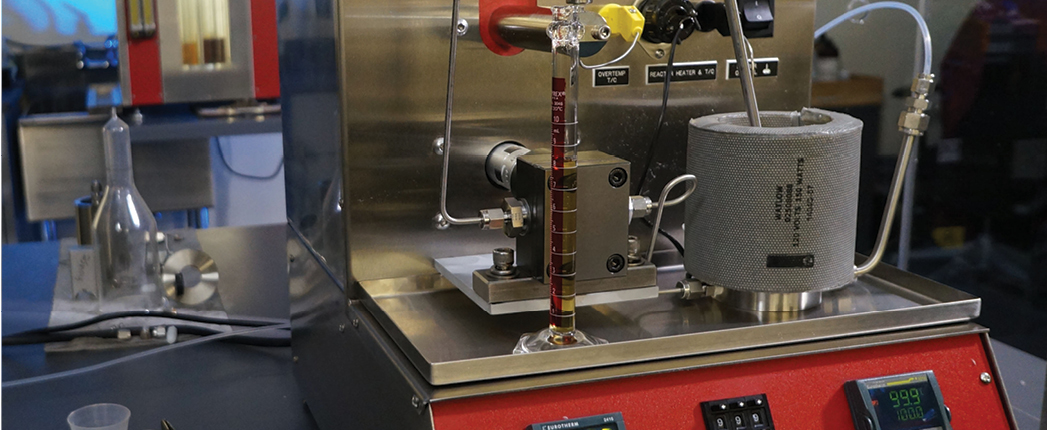
Lubricant bench tests are small-scale tests examining a specific aspect of a lubricant’s performance. Faster and cheaper than full-scale tests, they can aid the research and development process. Additive component and package developers, lubricant marketers and original equipment manufacturers all use bench tests. This is the first of two articles and explores the use of bench tests in specifications, their relationship to “real world” performance and whether they can unnecessarily constrain the chemistry options for lubricant formulators.
Lubricant Bench Tests
Lubricant bench tests take many forms. They usually focus on a specific performance area of the lubricant, like oxidation, corrosion, rust, aeration, shear stability, filterability, friction or seal compatibility. They accelerate the conditions causing the performance characteristic and can be cheaply and quickly employed to gain mechanistic insights and screen new additives and/or formulations. More expensive and lengthier rig, engine and field tests can then be run on pre-screened candidates, which potentially have the best performance (Figure 1).

Some tests are considered proprietary by the inventing company and used to give a competitive edge in component or formulation development. Others are publicly available and find their way into original equipment manufacturer and industry specifications.
History
The drive to increase the speed of R&D and the increasing cost of full hardware testing has led to greater use of bench tests. Ricardo Bloch, a retired industry chemical engineer based in the United States, told Lubes’n’Greases, “Many new automotive bench tests emerged in the 1980s, including the TEOST 33C and TEOST MHT-4 oxidation tests, the diesel injector test for shear stability and the NOACK evaporation test for engine oils. OEMs also picked up on these tests for their specifications.”
Paul Ransom, formulation developer with Afton Chemical, said, “Most European OEMs, including Daimler, PSA, Renault, VW and Ford, either have one or more in-house bench tests in specifications or use standard industry tests with their own limits.”
Most transmission fluid specifications have relied on bench testing for decades to test oxidation, seals, friction and wear.
For industrial oils, Stephen Gotheridge, technology development manager hydraulic fluids for Lubrizol, said: “Hydraulic oil test methods written as far back as the 1950s are still used today, whether appropriate or not. Specifications written in the 1970s from long-forgotten companies are still highly favored for performance claims by oil marketers.” Industrial gear oil also contains a mix of legacy and newer specifications. Bench tests for greases have been used for decades and remain widely used for product development and in specifications.
Bench Tests in Specifications
The inclusion of bench tests in specifications aims to control testing costs and increase speed to market, but concerns exist. Steve Haffner of U.S.-based SGH Consulting said: “Great care must be taken when using bench tests in some crankcase oil specifications to avoid issues. Where bench tests have significant variability or if the relationship to a given chemistry does not reflect ‘real world’ performance, this can allow marginal lubricants or prevent effective chemistries from being used.”
Ransom said of crankcase oxidation: “Hotter bench tests give results in a shorter time but may not be entirely representative of either high-temperature engine operation or bulk fluid temperature. It’s possible that shorter, hotter tests introduce different mechanisms.”
Bloch concurred. “No bench test can handle a high-temperature-specific environment and bulk oil oxidation simultaneously,” he said.
Jason Hanthorn, Lubrizol’s technology development manager-consumer lubricants, said: “Tests like the TEOST 33C are designed to mimic high-temperature cycles experienced by turbochargers, which may add value because there is no specific API engine test.” He added, “This test may have more utility for smaller volume, high severity applications, such as motorcycles, where there is no dedicated hardware test in the API specification.”
For friction bench testing, Hanthorn said, “Bench tests, such as HFRR or MTM, can be helpful for directional fuel economy performance, although not replicating everything happening in a combustion engine.”
Mary Galic, Lubrizol’s technology development manager-commercial lubricants, said, “Specifically for diesel engine oils, the added complexity of engine soot type and chemistry is never fully replicated in a bench test. Key performance areas such as soot-related wear and viscosity increase can be very difficult to model.”
As specifications are upgraded, bench tests may remain for long periods even when they become less relevant to modern hardware. “There is a reluctance to remove tests from specifications, so the list keeps growing,” Ransom said.
There is progress, though. “ILSAC determined that two bench tests in the latest GF-6 specification, TEOST 33C and MHT-4 tests, were redundant or no longer needed and other tests ensured adequate performance (TEOST 33C remains in GF-6A only for backwards compatibility),” Haffner said. “Others like seals tests, remain and act more like ‘no harms’ tests.”
In Europe, “the latest CEC seal compatibility method was overhauled to use more representative materials and address supply and EHS issues,” Ransom said.
For transmissions, the fluid environment is somewhat simpler than for crankcase oils, because there are no exhaust gases. Specifically for oxidation, bench tests like the ABOT and ISOT can simulate the basic oxidation processes and examine their impact on wear, friction and shift quality. Bloch added, “Friction stability after oxidation is best modeled by the anti-shudder tests SAE#2 machine with oxidation.”
In hydraulic oils, Gotheridge noted the reluctance to remove older bench tests from specifications. “This results from the many specifications around the world from industry consortia and OEMs,” he said. “Once a product claims such performance, it becomes very difficult to eradicate those claims from the market.”
A similar situation exists for IGO. David Hobson, Lubrizol’s technology development manager-industrial gear oils, said: “Many legacy tests remain in specifications despite more relevant tests being available; for example, FZG gear tests, FE-8 bearing tests, DGMK377 gear wear and FVA54 micropitting tests relate to more realistic, real world operating conditions than their predecessors, such as the Timken, 4-ball and Brugger. The new tests are included in some specification upgrades but not others.”
One concern for greases is that lubricant bench tests may not correctly take into account the differences in physical properties.
Bench Test Correlation to the “Real World”
Developing a lubricant bench test can be straightforward, but some relevance to the “real world” lubricant application is essential to provide valid data. For engine oils, bench test correlations to the field are very difficult and good technical judgment is vital. “It requires a significant amount of time, resources and testing to develop a bench test to accurately predict performance in an engine test,” Hanthorn said. “Specifications evolve rapidly to reflect OEM views on field performance, and there is limited value in trying to keep pace with bench tests.”
In bench test development, reference oils of known field performance are widely used to show some level of discrimination. This does not necessarily mean all oils tested will respond in a similar way to reference oils, and correlation to actual performance in hardware has been questioned. “If bench tests are not appropriate,” Ransom said, “bench and engine and field responses may conflict. For example, a bench test sets a maximum level of a particular chemistry, but better engine and field performance requires a minimum level of the same chemistry or a different formulation solution.”
Improvements could be made by “having field-relevant data and fluids that discriminate between good and bad field performance. This drives the need rather than addressing a perceived potential risk,” Ransom said. Figure 2 is an example for used oil pumpability.

Stakeholders generally agree that for bench tests to correlate to real world conditions, appropriate test conditions and chemical mechanisms are critical along with correct hardware choices, reference oils and statistical precision monitoring.
For transmission tests, Afton’s marketing manager for e-mobility, Adam Banks, cautioned: “If the test is made too severe in order to provide accelerated testing, then the link back to the real mechanism can be lost along with the correlation to the field. The failure mode can be changed by ramping up severity too far.”
In hydraulics, field trials are expensive and difficult to manage in a controlled manner. “The diversity and differing severity of hydraulic equipment hinders statistical correlation back to bench testing,” Gotheridge said. “Condition monitoring of lubricants in the field is essential to monitor lubricant health. Relating this data back to performance in bench testing is necessary to aid correlation.”
For greases, more complex tests, including “contact” tests, examining several performance aspects, tend to relate better to the “real world” application.
Impacts on Formulation Development
If bench tests are included in lubricant specifications, they may limit formulation options. “Crankcase oil formulation flexibility can be limited by bench tests, but screening for a failure mechanism in the field is acceptable,” Ransom said. “Formulators balance components to minimize risk across applications.”
Hanthorn said: “Older tests, like the TEOST MHT and Ball Rust test, can have a formulating appetite different to the engine tests in a given specification (e.g. API SL) and may require component choices specifically to address that test. A formulation can have excellent cleanliness in multiple engine tests and poor TEOST performance (and vice versa), so the TEOST MHT does define some formulations.”
China National GB engine oil standards include the TEOST 33C bench test, which is used for product compliance. If found failing, lubricant marketers can be fined, but test variability can be an issue. “Over-formulation” may occur, increasing the additive treat and product cost to better ensure compliance. Crankcase seals tests can also be problematic as some materials used are no longer used in engines. In severe cases, this may unnecessarily limit the formulation chemistry.
For transmission fluids, Banks emphasized that “too extreme test conditions to accelerate the test can become formulation defining.” For e-transmission fluids, new copper compatibility and corrosion tests are being developed. “Extreme copper protection may not be best for OEMs and consumers,” Banks said. “A sensible balance is needed to maintain advantages across the whole application.”
Inappropriate hydraulic oil bench tests can force the formulator to optimize the formulation specifically to pass those tests. Gotheridge cited “the inclusion of excessive extreme pressure componentry to pass IGO tests, such as FZG or Brugger EP performance. This may propagate sludge generation in field applications with no additional benefit in preventing wear and be detrimental to the lubricant and the equipment.”
For IGO, Hobson said, “It becomes particularly challenging to combine the requirements of legacy and state-of-the-art specifications.” He added: “This underlines the importance of product specification maintenance. Legacy tests not only limit formulating freedoms but in some cases inhibit real world performance boosts from being realized.”
Conclusions
Lubricant bench testing has been used for decades to provide faster, less costly and more focused testing. For simpler lubrication systems, bench tests can work well to understand mechanisms and to screen for components and formulations in R&D projects. Their use in specifications allows industry or OEMs to set limits around specific performance parameters, which is fine where the limitations are taken into account. The concerns around bench tests focus on:
- Continuation in specifications beyond their relevance to current hardware.
- Correlation to actual field conditions.
- Test variability, test limit severity and restrictions to formulation developers.
Bench tests may be better suited to R&D-type activities, looking at directional trends, understanding chemical mechanisms or screening additives and formulations ahead of more expensive testing programs. Ultimately for bench tests, their value depends on your need and perspective.
Philip Reeve is a chemist with 40 years of experience in the global lubricants and additives industry. He’s held positions at Afton, Infineum and ExxonMobil and is now a director of ADLU Consultancy. Contact him at philipreeve@adlu-consultancy.com.